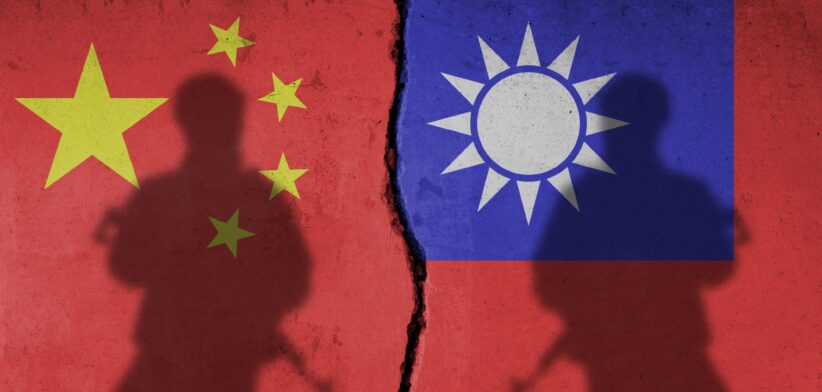With wars in the Middle East and Eastern Europe escalating and dominating headlines, there is a risk potential conflict closer to home, in Taiwan, is falling off the radar. Senior Defence and Security Analyst Steve Kuper argues Australia needs to remain alert to regional threats following recent war games which, he says, has Beijing now believing the United States is less likely to intervene in the defence of Taiwan due to major “systemic weaknesses”. Here is Mr Kuper’s analysis and the wider implications for Australia:
Over recent years, cross-strait relations between Taiwan and the People’s Republic of China (PRC) have entered a period of heightened tension and uncertainty, prompting growing concern across the Indo-Pacific and among the international community.
While relations have long been marked by underlying friction, recent developments have seen a clear deterioration in political, military, and strategic trust between Taipei and Beijing.
The shift has been particularly pronounced since the election of President Tsai Ing-wen and her Democratic Progressive Party (DPP) in 2016, with their firm rejection of Beijing’s “One China” principle and refusal to endorse the 1992 Consensus.
This stance has been met with escalating pressure from the PRC, which considers Taiwan a breakaway province and has not ruled out the use of force to achieve unification.
In response, China has dramatically intensified its political, economic, and military coercion against Taiwan, conducting near-daily incursions into Taiwan’s Air Defence Identification Zone (ADIZ), expanding grey-zone operations, and increasing joint military drills simulating a blockade or invasion.
This escalation has alarmed regional actors and global powers alike, particularly the United States, which remains Taiwan’s most important security partner under the Taiwan Relations Act.
Washington has responded with an increased tempo of naval transits through the Taiwan Strait, growing arms sales to Taipei, and elevated political engagement. While officially maintaining a position of strategic ambiguity, successive U.S. administrations have signalled stronger rhetorical and military support for Taiwan’s self-defence, a move that Beijing views as provocative and destabilising.
Amid these developments, fears of an open conflict, triggered either by miscalculation, crisis escalation, or deliberate use of force have grown. The potential outbreak of war over Taiwan is now widely considered one of the most dangerous flashpoints for global conflict.
Analysts warn that any military clash could rapidly draw in the United States and its allies, reshaping the strategic landscape of the Indo-Pacific and beyond. For Australia and like-minded partners, the worsening cross-strait situation raises profound questions about deterrence, preparedness, and the long-term stability of the region.
As tensions continue to rise, the balance between peace, deterrence, and strategic competition remains precariously uncertain, this will only become more prominent if the findings from Taiwan’s latest round of war games are to be believed.
Highlighting this is Taipei-based Lawrence Chung for the South China Morning Post in a piece titled ’Taiwan war game triggers US questions over island’s “will to fight” if PLA attacks’ in which he states, “The exercise simulating a 2030 assault by the PLA highlighted ‘systemic weaknesses’ that may make America more reluctant to intervene.”
Taiwan must be willing to fight
Findings from a recent high-level civilian war game held in Taipei has exposed serious vulnerabilities in Taiwan’s defences, particularly concerning its outer perimeter and eastern regions.
Organised by three Taiwanese think tanks led by the Taipei School of Economics and Political Science, the two-day simulation is among the most detailed publicly conducted strategic exercises modelling a full-scale assault by mainland Chinese forces. It reflects mounting concerns among local strategists and retired military leaders that Taiwan’s eastern flank and offshore islands remain dangerously exposed amid intensifying People’s Liberation Army threats.
The exercise, simulating a 2030 cross-strait conflict, saw Taiwan lose control of key outlying territories, most notably Penghu, a group of islands 50km east of the main island as the People’s Liberation Army (PLA) launched a multi-front assault that quickly outpaced Taiwan’s initial response.
Chung explained, saying, “In the opening phase, the PLA sent state-affiliated vessels within 12 nautical miles (22km) of the island – the international limit for territorial waters. The Taiwan team avoided direct engagement, instead deploying coastguard and navy ships to shadow the vessels and positioning submarines in “ambush zones” northeast and southwest of the island.”
The war game involved four teams representing Taiwan, the United States, Japan, and mainland China, overseen by a control group. Notable participants included Michael Mullen, a former chairman of the US Joint Chiefs of Staff; Dennis Blair, a former US Pacific commander; and Shigeru Iwasaki, former chief of staff of Japan’s Self-Defence Forces. Nine retired Taiwanese generals and admirals, including Lee Hsi-min, former chief of the general staff, and eight lieutenant generals also took part.
“Tensions escalated in the second phase as Beijing deployed three PLA carrier strike groups across the South China Sea and the first and second island chains. Mainland coastguard ships also began inspecting and diverting energy tankers and US arms shipments bound for Taiwan,” Chung explained further.
“The first and second island chains – strategic defence lines extending from mainland Japan, through Okinawa and Taiwan to the Philippines, and farther out to Guam – are key to the US strategy of containing PLA naval expansion. Their control is crucial for limiting PLA access to the Pacific,” he said.
While the outcome of the war game, whether the PLA ultimately seized Taiwan has not been made public, but the organisers have indicated they will issue a full report.
The exercise has prompted a retired US admiral to warn that Washington’s involvement in such a conflict would depend on “Taiwan’s will to fight.”
Chung detailed this saying, “By phase three, the PLA had seized the Taiwanese-controlled Pratas Island, or Dongsha, imposed a naval blockade, launched long-range missile and cyberattacks against Taiwan’s financial and energy infrastructure and even sunk two Taiwanese warships.
“At this point, prices for flights leaving Taiwan surged thirtyfold, fuelling public outrage over perceptions that only the wealthy could flee. When asked by the US team whether Taiwan would attempt to retake Dongsha, Team Taiwan declined. This inaction prompted sharp criticism from the control group, which extended the phase and warned Taiwan’s team to “go home tonight and seriously consider a response”,” Chung explained.
Going further, despite defensive efforts to hold off the invasion of the Taiwanese mainland, the US contributors warned, “a collapse in morale among the Taiwanese government or public would severely compromise the military’s will to resist.”
Unpacking the long-haul fight Taipei would be in for, the US contributors reinforced, “The US players estimated Taiwan’s forces would need to hold out for two to three weeks until reinforcements could arrive. While threats from North Korea and Russia might complicate planning, the US team said these would not change Washington’s strategic objectives in the Taiwan Strait.”
Chung, speaking to Lee Wen-chung, former director of the government-funded Institute for National Defence and Security Research, explained the precarious position Taiwan finds itself in saying, “Taiwan’s will to fight will have a great deal of effect” on US decisions. If a conflict were triggered by Taiwanese moves towards formal independence, he added, US support would be far less certain.”
And that should send shockwaves through Australia’s own strategic policy and political leaders.
Final thoughts
The Taiwanese war game simulation offers a sobering glimpse into the potential realities of a cross-strait conflict, revealing not just military vulnerabilities but deep systemic weaknesses in political leadership, public preparedness, and national will.
For Beijing, these perceived shortcomings reinforce the narrative that the United States may hesitate to intervene unless Taiwan demonstrates a credible and enduring will to fight.
Meanwhile for Washington, it raises hard questions about how much risk it is willing to assume on behalf of an ally unwilling to match its own resolve.
Crucially, the implications go far beyond Taiwan. For Australia, this is not a distant geopolitical drama it is a pressing strategic warning.
Australia can no longer afford to rely on optimistic assumptions about the permanence or reliability of American intervention. Nor can it treat regional conflicts as “someone else’s problem.”
Taiwan’s situation illustrates the increasingly conditional nature of allied support in an era of grey-zone coercion, accelerated escalation, and contested resolve.
To adapt, Australia should:
Reinforce Sovereign Resilience and Will to Fight:
- Public support for national defence must be nurtured through honest dialogue, education, and national service debates.
- Defence force readiness and reserve mobilisation plans must be stress-tested and regularly exercised with visible national engagement.
- Psychological resilience, information warfare resistance, and societal cohesion must be treated as core elements of national security.
Prioritise Independent, Networked Deterrence:
- Australia must deepen its sovereign strike, ISR, and maritime denial capabilities, not merely to support allies, but to shape adversary calculations independently.
- Investments in autonomous systems, cyber, space, and hardened basing must be accelerated, especially across northern Australia.
Reframe Alliance Expectations:
- Australia’s alliance with the United States remains indispensable, but it must be one of capable equals, not dependency.
- Canberra must accept that U.S. involvement in future conflicts will likely be shaped by cold calculations of political will, risk, and credibility—meaning burden-sharing must be genuine, not symbolic.
Take Indo-Pacific Partnerships Seriously:
- Japan, India, Indonesia, and the Philippines are increasingly critical partners. Australia must build credible, sustained defence and strategic cooperation that goes beyond episodic exercises or aid packages.
- An Indo-Pacific security community must include credible regional deterrence architectures, not just bilateral dependencies.
Challenge Strategic Complacency at Home:
- The Taiwanese simulation should serve as a wake-up call for Canberra. Defence and national security policy cannot be delayed by short-term politics, procurement indecision, or institutional inertia.
- A war over Taiwan—or anywhere else in the Indo-Pacific would irreversibly transform Australia’s strategic environment. Preparation must begin before the crisis.
Because if we don’t, when it comes to paying the bill, the cost will be too devastating to comprehend.
– This article was first published on Australian defence sector integrated market intelligence platform Defence Connect.








